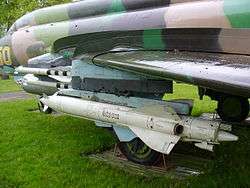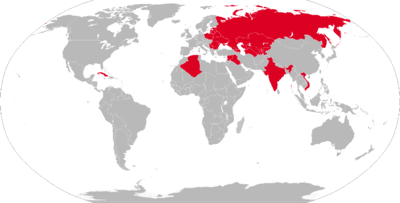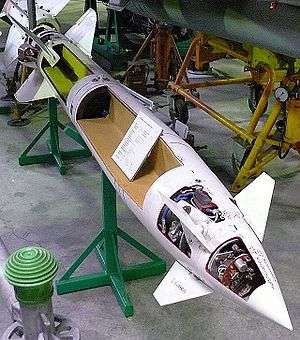Kh-23 Grom
| Kh-66/Kh-23 Grom (NATO reporting name: AS-7 'Kerry') | |
|---|---|
|
AS-7 'Kerry' | |
| Type | Tactical air-to-surface missile |
| Place of origin | Soviet Union |
| Service history | |
| In service |
Kh-66 :20 June 1968[1] Kh-23 :1973[2] Kh-23M :1974[2] |
| Used by | FSU, Warsaw Pact, Iraq, India[3] |
| Production history | |
| Designer | Yurii N. Korolyov[1] |
| Manufacturer | Zvezda-Strela |
| Specifications | |
| Weight | A921 :287 kg (633 lb)[3] |
| Length | A921 :3.525 m (11 ft 7 in)[3] |
| Diameter | 27.5 cm (10.8 in)[3] |
| Warhead weight | 111 kg (245 lb)[3] |
|
| |
| Engine | Solid fuel rocket[3] |
| Wingspan | 78.5 cm (2 ft 6.9 in)[3] |
Operational range | 2–10 km (1.1–5.4 nmi)[3] |
| Speed | 2,160–2,700 km/h (1,340–1,680 mph)[3] |
Guidance system |
Kh-66 :Line-Of-Sight Beam riding Kh-23 :Radio command guidance Grom-B :TV guidance |
Launch platform |
Mig-21PFM, MiG-23, MiG-27, Su-17M3/20/22/22M3/M4,[3] |

The Zvezda Kh-66 and Kh-23 Grom (Russian: Х-23 Гром 'Thunder'; NATO:AS-7 'Kerry') are a family of early Soviet tactical air-to-surface missiles with a range of 10 km. They were intended for use against small ground or naval targets. The Kh-66 was effectively a heavy-warhead, beam-riding version of the K-8 (AA-3 'Anab') air-to-air missile rushed into service in Vietnam in 1968. The Kh-23 was an improved Kh-66 with command-guidance, similar to the AGM-12 Bullpup.
Development
Work on air-to-air missiles had started at the Kaliningrad Engineering Plant (then known as Plant #455, and later merged into Zvezda-Strela) in 1955.[1] This had resulted in the Kaliningrad K-5 (AA-1 'Alkali') family of beam-guided missiles, including the K-51 (RS-2-US) carried by the Su-9 'Fishpot'. OKB-4 Molniya (later Vympel NPO) under Matus Bisnovat would go on to produce missiles such as the AA-6 Acrid.[1] Meanwhile, in 1963 the RS-2-US was tested as an air-to-surface missile.[1] It was concluded that the small warhead and inaccurate guidance made such an application "pointless".[1]
However, in 1965 North Vietnam requested an air-to-surface missile from the Soviet government;[1] the AGM-12 Bullpup had entered service with the US Air Force before the start of the Vietnam War. In April 1965 OKB-134 (later NPO Vympel) started work on this missile under the project name Kh-23, but they had problems developing a guidance system that would work with existing aircraft.[3] As a result, Yurii N. Korolyov came up with his own proposals based on the earlier experiments with the RS-2-US. A design bureau to develop the RS-2-US for surface targets was set up under Korolyov by decree #100 of 12 March 1966 of the Ministry of the Aircraft Industry;[1] this bureau would become the Zvezda OKB in 1976.[4]
The resulting weapon used the body of a K-8 (AA-3 'Anab') K-5 guidance and propulsion systems but increased the warhead from 13 kg (29 lb) to 100 kg (220 lb).[5] This had the big advantage of allowing the new weapon to be fitted to any aircraft capable of firing the K-5.[3] Design began in 1966,[4] so the project was known as Kh-66 or Izdeliye 66 ('Article 66'). The Kh-66 was a beam-riding weapon that was tested on a MiG-21PFM[4] and entered production in 1968 for that aircraft. The Kh-66 was only an interim solution as it required the launch aircraft to dive towards the target to maintain lock on the target. Flight testing of the Kh-66 began in 1967[1] and it entered service on 20 June 1968.[1]
Meanwhile, Korolyov took over work on the Kh-23 project intended for carriage on the Soviet Union's new Mig-23.[3] The Kh-23 became a development of the Kh-66 design with an improved propellant and new Delta-R1M guidance system.[3] The main practical difference was that it was a line-of-sight radio-command weapon similar to the Bullpup, allowing it to be fired in level flight (unlike the Kh-66). The first ten were tested in early 1968,[3] but significant delays were caused by problems with unreliable guidance which was eventually traced to the smoke generator which interfered with the antenna.[3] Once the receiver had been moved to a tail extension,[3] the government tested the missile on the MiG-23 and MiG-23B between 20 March 1970 and 3 October 1973.[1] and it entered service in 1973.[2] A laser-guided version of the Kh-23, the Kh-25, became the basis for the AS-10 'Karen' family of missiles.[1] Technology from these was 'backported' to the Kh-23 to create the Kh-23M in 1974.[2]
The Kh-23 was later licensed for local production in both Romania and Yugoslavia.[3] In 1977 a dummy Kh-23 was fired from a Ka-252TB helicopter,[1] the prototype of the Kamov Ka-29TB 'Helix-B' assault transport.
Design
The Kh-66 used the airframe of the Kaliningrad K-8 (AA-3 'Anab') air-to-air missile, with the nozzle split to make room for the antenna of the beam-riding guidance system of the Kaliningrad K-5 (AA-1 'Alkali').[3] It has cruciform control fins on the nose, and four clipped-tip delta-wings at the rear with elevators for control.
Operational history
The Kh-66 entered production for the MiG-21 in 1968, and the Kh-23 was certified for the MiG-23 'Flogger' in 1973.
Variants

- Kh-66 - the original beam-riding missile based on the K-8
- Kh-23 (Izdeliye 68)[4] - First command-guidance version with improved propellant
- Kh-23M - improved Kh-23 with technology from the Kh-25 family[2]
- Kh-23L - Western name for a laser-guided version that in fact was the baseline Kh-25 (AS-10 'Karen')[4]
- A921 - Version made in Romania under licence[3]
- Grom (Grom 02) - Yugoslav version that appeared in the 1980s.[6] This should not be confused with the Polish SAM
- Grom-B (Grom 2) - TV-guided version from Serbia's Vojno-Tehnički Institut in the mid-late 1990s; uses seeker based on that of AGM-65B Maverick[6]
Operators

 North Korea
North Korea  Serbia Grom-A and Grom-B are locally produced. The Grom-B has the AGM-65 Maverick guidance system.
Serbia Grom-A and Grom-B are locally produced. The Grom-B has the AGM-65 Maverick guidance system.
Former operators
-
 Algeria
Algeria -
 Soviet Union[3] - passed onto successor states
Soviet Union[3] - passed onto successor states -
 Bulgaria[3]
Bulgaria[3] -
 Cuba
Cuba -
 India[3]
India[3] -
 Iraq[3] - as of Saddam's Era
Iraq[3] - as of Saddam's Era -
 Poland[3]
Poland[3] -
 Romania (A921)[3]
Romania (A921)[3] -
 Serbia (Grom)[3]
Serbia (Grom)[3] -
 Syria[7]
Syria[7] -
 Vietnam [8]
Vietnam [8]
Similar weapons
- AGM-12 Bullpup
- AS-20 - French air-to-ground missile based on an early air-to-air missile
Notes
| Wikimedia Commons has media related to Kh-23. |
- 1 2 3 4 5 6 7 8 9 10 11 12 13 History of JSC Tactical Missile Corporation (Word 97 DOC), pp. 3–4, retrieved 2009-02-15
- 1 2 3 4 5 "Russian Air-to-Ground Missile Update", Jane's Missiles and Rockets, 1998-02-01, retrieved 2009-02-18
- 1 2 3 4 5 6 7 8 9 10 11 12 13 14 15 16 17 18 19 20 21 22 23 24 25 26 27 Friedman, Norman (1997), The Naval Institute Guide to World Naval Weapons Systems, Naval Institute Press, p. 235, ISBN 978-1-55750-268-1
- 1 2 3 4 5 "Kh-23, Kh-66 Grom (AS-7 'Kerry')", Jane's Air-Launched Weapons, 2008-08-01
- ↑ FAS, Zvezda Kh-23 (AS-7 Kerry), retrieved 2007-04-15
- 1 2 "Serbia and Montenegro develops 'smart' strike weapons", Jane's Missiles and Rockets, 2005-05-12, archived from the original on August 24, 2005, retrieved 2009-02-18
- ↑ https://www.youtube.com/watch?v=zJECq1Sk_5A
- ↑ http://www.facebook.com/photo.php?fbid=329103990545901&set=a.213966772059624.43591.213961285393506&type=1&theater
References
- Gordon, Yefim (2004), Soviet/Russian Aircraft Weapons Since World War Two, Hinckley, England: Midland Publishing, ISBN 1-85780-188-1
